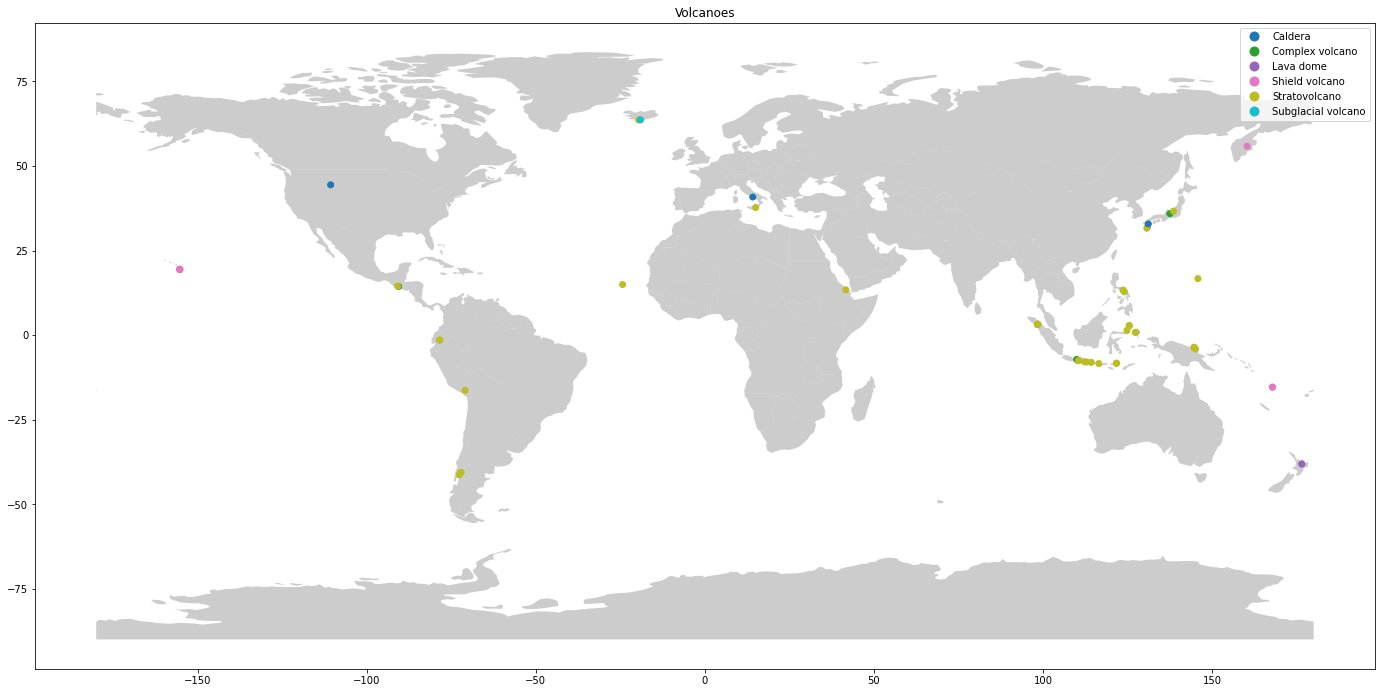Note
Plotting with Folium¶
What is Folium?
Folium builds on the data wrangling strengths of the Python ecosystem and the mapping strengths of the leaflet.js library. This allows you to manipulate your data in Geopandas and visualize it on a Leaflet map via Folium.
In this example, we will first use Geopandas to load the geometries (volcano point data), and then create the Folium map with markers representing the different types of volcanoes.
Load geometries¶
This example uses a freely available volcano dataset. We will be reading the csv file using pandas, and then convert the pandas DataFrame to a Geopandas GeoDataFrame.
[1]:
# Import Libraries
import pandas as pd
import geopandas
import folium
import matplotlib.pyplot as plt
[2]:
df1 = pd.read_csv('volcano_data_2010.csv')
# Keep only relevant columns
df = df1.loc[:, ("Year", "Name", "Country", "Latitude", "Longitude", "Type")]
df.info()
<class 'pandas.core.frame.DataFrame'>
RangeIndex: 63 entries, 0 to 62
Data columns (total 6 columns):
# Column Non-Null Count Dtype
--- ------ -------------- -----
0 Year 63 non-null int64
1 Name 63 non-null object
2 Country 63 non-null object
3 Latitude 63 non-null float64
4 Longitude 63 non-null float64
5 Type 63 non-null object
dtypes: float64(2), int64(1), object(3)
memory usage: 3.1+ KB
[3]:
# Create point geometries
geometry = geopandas.points_from_xy(df.Longitude, df.Latitude)
geo_df = geopandas.GeoDataFrame(df[['Year','Name','Country', 'Latitude', 'Longitude', 'Type']], geometry=geometry)
geo_df.head()
[3]:
| Year | Name | Country | Latitude | Longitude | Type | geometry | |
|---|---|---|---|---|---|---|---|
| 0 | 2010 | Tungurahua | Ecuador | -1.467 | -78.442 | Stratovolcano | POINT (-78.44200 -1.46700) |
| 1 | 2010 | Eyjafjallajokull | Iceland | 63.630 | -19.620 | Stratovolcano | POINT (-19.62000 63.63000) |
| 2 | 2010 | Pacaya | Guatemala | 14.381 | -90.601 | Complex volcano | POINT (-90.60100 14.38100) |
| 3 | 2010 | Sarigan | United States | 16.708 | 145.780 | Stratovolcano | POINT (145.78000 16.70800) |
| 4 | 2010 | Karangetang [Api Siau] | Indonesia | 2.780 | 125.480 | Stratovolcano | POINT (125.48000 2.78000) |
[4]:
world = geopandas.read_file(geopandas.datasets.get_path('naturalearth_lowres'))
df.Type.unique()
[4]:
array(['Stratovolcano', 'Complex volcano', 'Shield volcano',
'Subglacial volcano', 'Lava dome', 'Caldera'], dtype=object)
[5]:
fig, ax = plt.subplots(figsize=(24,18))
world.plot(ax=ax, alpha=0.4, color='grey')
geo_df.plot(column='Type', ax=ax, legend=True)
plt.title('Volcanoes')
[5]:
Text(0.5, 1.0, 'Volcanoes')

Create Folium map¶
Folium has a number of built-in tilesets from OpenStreetMap, Mapbox, and Stamen. For example:
[6]:
# Stamen Terrain
map = folium.Map(location = [13.406,80.110], tiles = "Stamen Terrain", zoom_start = 9)
map
[6]:
[7]:
# OpenStreetMap
map = folium.Map(location = [13.406,80.110], tiles='OpenStreetMap' , zoom_start = 9)
map
[7]:
[8]:
# Stamen Toner
map = folium.Map(location = [13.406,80.110], tiles='Stamen Toner', zoom_start = 9)
map
[8]:
This example uses the Stamen Terrain map layer to visualize the volcano terrain.
[9]:
# Use terrain map layer to see volcano terrain
map = folium.Map(location = [4,10], tiles = "Stamen Terrain", zoom_start = 3)
Add markers¶
To represent the different types of volcanoes, you can create Folium markers and add them to your map.
[10]:
# Create a geometry list from the GeoDataFrame
geo_df_list = [[point.xy[1][0], point.xy[0][0]] for point in geo_df.geometry ]
# Iterate through list and add a marker for each volcano, color-coded by its type.
i = 0
for coordinates in geo_df_list:
#assign a color marker for the type of volcano, Strato being the most common
if geo_df.Type[i] == "Stratovolcano":
type_color = "green"
elif geo_df.Type[i] == "Complex volcano":
type_color = "blue"
elif geo_df.Type[i] == "Shield volcano":
type_color = "orange"
elif geo_df.Type[i] == "Lava dome":
type_color = "pink"
else:
type_color = "purple"
# Place the markers with the popup labels and data
map.add_child(folium.Marker(location = coordinates,
popup =
"Year: " + str(geo_df.Year[i]) + '<br>' +
"Name: " + str(geo_df.Name[i]) + '<br>' +
"Country: " + str(geo_df.Country[i]) + '<br>'
"Type: " + str(geo_df.Type[i]) + '<br>'
"Coordinates: " + str(geo_df_list[i]),
icon = folium.Icon(color = "%s" % type_color)))
i = i + 1
[11]:
map
[11]:
Folium Heatmaps¶
Folium is well known for its heatmaps, which create a heatmap layer. To plot a heatmap in Folium, you need a list of latitudes and longitudes.
[12]:
# This example uses heatmaps to visualize the density of volcanoes
# which is more in some parts of the world compared to others.
from folium import plugins
map = folium.Map(location = [15,30], tiles='Cartodb dark_matter', zoom_start = 2)
heat_data = [[point.xy[1][0], point.xy[0][0]] for point in geo_df.geometry ]
heat_data
plugins.HeatMap(heat_data).add_to(map)
map
[12]: